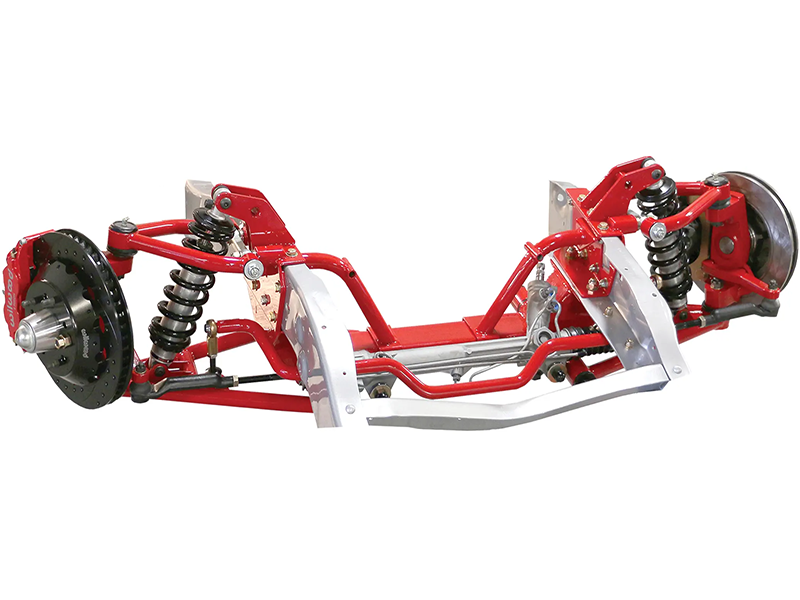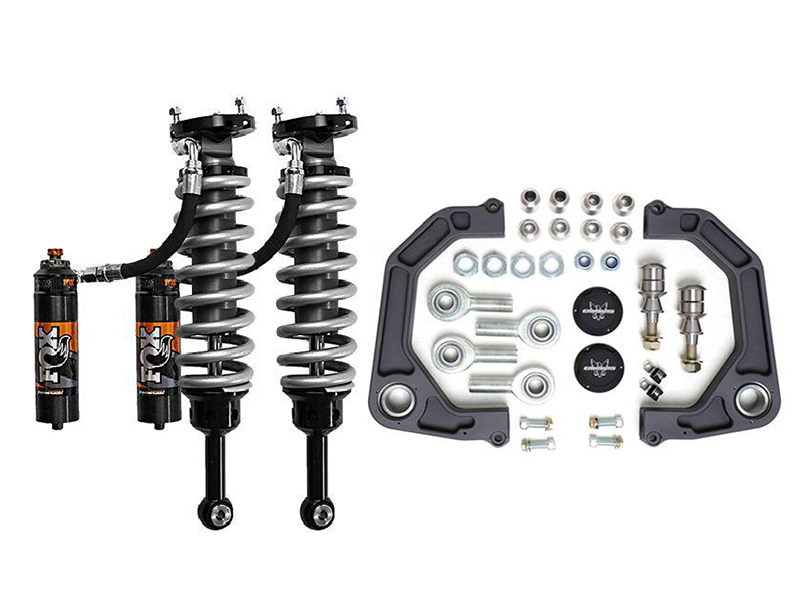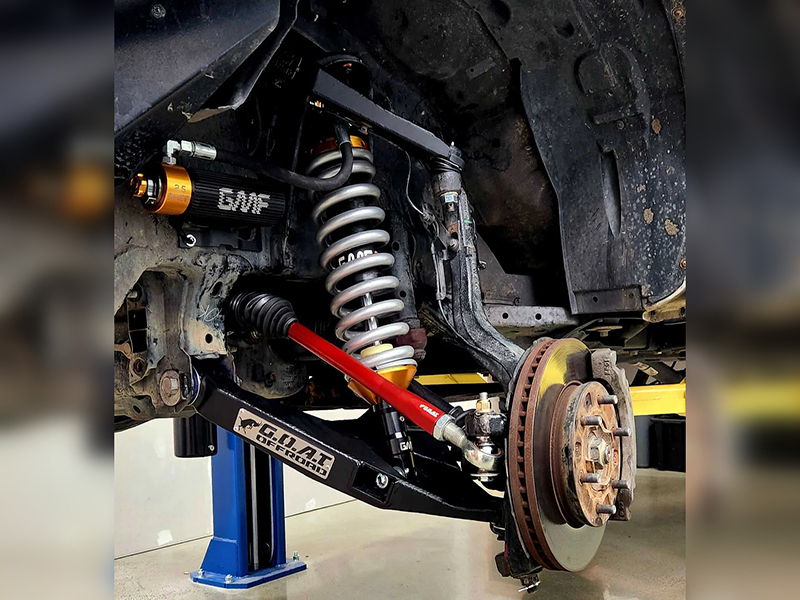Main Differences Between Mid- and Long-Travel Suspensions
If you own a pickup truck or SUV outfitted with an independent front suspension, then the terms “mid travel” and “long travel” should sound familiar. Such vehicles as the Chevy Silverado, Toyota Tacoma, and Ford F-150 all became favorites with aftermarket suspension component manufacturers. These companies offer a considerable variety of both mid- and long-travel kits for these vehicles, which ensure tens of thousands of miles of reliable driving. If you would like to learn about the differences between these kits, while understanding exactly which one you might need for your rig, then you should definitely read on. The following article opens up to its readers the universe of off-roading suspension performance while answering plenty of questions. It provides the necessary information so that you could make an informed choice while purchasing the next kit.
What Are the Main Working Principles of an Independent Front Suspension?
Before we are going to get into the comparison of the kit types, it is fairly important to learn exactly what an IFS system is and what it’s composed of. IFS is an acronym for the independent front suspension, which describes any design of the front suspension that lets its wheels move independently. Majority of present-day IFS systems are engineered utilizing the very same types of basic components, which allow for their durability and robustness. These include both lower and upper control arms, knuckles (also called spindles), coilovers (also called shocks), and steering tie rods. Besides, most 4x4 vehicles with independent front suspensions come with axle shafts with constant velocity joints to power the front wheels. Even if plenty of IFS vehicles share the aforementioned components, they may still differ in their designs, materials, shapes, and places of mounting.
How Is Suspension Travel Defined?
Suspension travel is measured in inches, being the distance between the wheels’ centerline from full compression to extension of the suspension. In general, it means exactly how many inches the wheels move, with more travel meaning more work for the shocks reacting to road surface irregularities.
The latter means less harshness transferred to the vehicle driver and passengers, thus ensuring better handling and quality of ride both on and off the road. Travel numbers are a fairly decent indicator of suspension performance, hence aftermarket companies often brag about exactly how much travel their products offer. However, any suspension performance fan should remember that more travel won’t necessarily mean better performance on unforgiving terrain. We will go on with our explanation exactly why greater travel numbers don’t always translate into better quality of ride later on in this article.
How Is Mid Travel Defined?
If you are looking for various options for your independent front suspension vehicle, then mid-travel kits are a sure way to go. Suspension-modding fans, 4x4ing shops, and off-roaders will agree that a quality mid-travel kit will ensure better performance than a leveling or lift kit. However, exactly what components are a part of it, what constitutes its work, and how will it make your suspension perform better than stock parts? We do not mean to confuse the reader, but neither aftermarket companies nor off-roading fans actually agree about exactly what mid travel is. Although, considering most of suspension packages, there are plenty of shared components that most enthusiasts would agree are critical to a mid-travel kit. Regardless of whether you are planning on taking onto desert sands or countryside roads, these kits will help your vehicle master any trail or road surface.
Usually, mid-travel kits are made up of two primary parts: aftermarket-sourced coilover shocks and stock-size UCAs with durable uniballs or ball joints.
A wide range of manufacturers, including Icon, King, and Fox, offer coilovers with extended travel, thus giving about an inch of extra suspension movement. Some other companies provide stock-length LCAs, which come with more lasting ball joints / uniballs; however, the latter is not critical to suspension performance. Mid-travel kits are designed to offer a considerable increase in suspension travel, but given the differences between platforms, the amount is undefined. Sometimes, aftermarket companies will provide the travel increase numbers, hence it may be worth the while to get this info from them directly. Although, it is worthy of noting that even if a decent mid-travel setup performs better than stock hardware, it won’t double the suspension travel.
How Is Long Travel Defined?
In the previous paragraphs we have described exactly what mid-travel kits are all about, now let’s continue with defining long-travel kits. To add to the aforementioned, plenty of suspension-modding enthusiasts have been debating the actual description of a long-travel kit. Some fans may say that a long-travel kit is called so only because of its upper mounting, while allowing for the longer shocks to be installed in place. Others may say that for as long as they have wider control arms and hence more considerable track width, they are certainly long-travel kits. However, one thing is clear: the long-travel kits are best used for modifying the suspension’s upper end, being the final word in bolt-on hardware. Anything beyond that requires extensive modification of the vehicle’s frame, which can be a tad too far for majority of present-day off-roading fans.
When given a thorough comparison, long-travel kits can be quite different from mid-travel ones, featuring considerably more components. The primary parts of long-travel kits include: extra-length UCAs, extra-length LCAs, extra-length steering tie rods, extra-length CV axle shafts. Besides, these kits may also include: extra-length brake lines, both bump stops and extensions, binding straps, and coilover shock absorbers.
Suspension systems that utilize long-travel kits do not use the orthodox upper and lower ball joints while employing more durable uniball ones. They offer plenty of different options, including secondary bypass shock absorbers, in order to ensure additional tunability and better damping. To add to the aforementioned, some of the long-travel kits supplied by different aftermarket companies also include more durable spindles.
After considering the description of the long-travel kits above, we are certain that the reader can grasp that the long-travel kits can be much more involving. When it comes to the front suspension, most of the primary components are being replaced with newly-engineered and -manufactured aftermarket ones. These parts are specifically created to allow for your vehicle to handle considerable abuse, as you are venturing off the beaten path while off-roading. However, it must be noted that the benefits of utilizing such kits for majority of off-roading and 4x4ing enthusiasts are fairly sound and understandable. Long-travel kits can surely be regarded as being the best of the best, especially when it comes to IFS systems and attainability for most fans. Although, what is the actual difference in-between mid- and long-travel kits, and are they are worthy of being installed on your vehicle?
Is There a Difference?
We have more than established that a long-travel suspension offers better performance than a mid-travel one, especially where greater articulation is desired. When it comes to comparing mid- and long-travel kits, there’s a wide range of performance advantages of the latter over the former. The long-travel kits offer increased track width, which ensures the vehicle a wider stance, thus translating into greater stability and better handling. Once your vehicle’s wheelbase is extended, you will have more space to articulate its suspension, with the frame and firewall not getting in the way. Very often long-travel suspension systems will also ensure considerable steering angles, while offering more precise, exacting steering. The parts in these kits are engineered to replace majority of O.E. components with more durable ones, including polyurethane bushings and alloy ball joints.
Additional Mods
Here’s the actual truth about the mid-travel suspension systems: their durability lies in their simplicity, which is quite often overlooked by modding fans. Stronger coilover shocks and upper control arms are what’s necessary for a beefy mid-travel system to master most of terrain, roads, and trails. Some of the enthusiasts could argue that adjusting coilovers for a higher lift would work fine, however, this may not always be the case. Any mid-travel suspension system will offer excellent performance, even on stock rims and all-terrain tires, while riding at automaker-specified height. It might make a variety of obstacles a tad too hard to drive over, but the ride won’t change if you want to raise the vehicle and increase the tire size. In general, mid-travel suspension systems do not need any other additional modifications to function as designed, all while ensuring superior quality of ride.
Long-travel suspension systems also require additional mods, because they increase the track of your off-roading vehicle by several inches. This means that now your pickup truck or SUV’s wheels will sit several inches beyond the wheel wells, thus requiring wide-body fenders. You will need to buy new fiberglass or carbon fiber fenders and rear bedsides, and get them installed and painted to match the vehicle. However, if you are going to only swap out the fenders, you won’t resolve all of the issues pending after your vehicle’s suspension lift. The O.E. front bumpers won’t match the aftermarket fenders, with most new, bolt-on front bumpers being designed for use on stock vehicles. It is likely that you will also have to purchase a custom bumper, which will be specifically made to match your pickup truck or SUV’s increased width.
There are plenty of long-travel systems that need a certain amount of wheel backspacing; hence, you may require new rims if you still have O.E. ones. And now, the new larger-size wheels will also require bigger-size tires, with only a few pickup trucks or SUVs with long-travel systems sporting stock tires. You will surely want to install the biggest-size tires on your vehicle, so as to make the utmost use of your modified suspension system. Besides, it is always a good idea to installs such components as gussets, while at the same time reinforcing the areas of high load on the chassis. Steering rack bushings, stock spindles, and control arm pivots are all subjected to considerable loads because of the greater leverage and wider track width. Hence, you have to keep in mind that the weld-on gussets will work okay if you are after permanently modding your rig’s frame.
Pricing
The actual cost of the suspension kits should also be given a consideration, with your pickup truck or sport ute’s modding prices being fairly important. There is a big difference in costs in-between mid- and long-travel suspension kits, especially if you are going to consider additional mods for the latter. An average mid-travel suspension system kit will come with a price tag from $1,500 to $2,500 for majority of present-day pickup trucks and sport utes. If you are going to consider the performance improvement over stock, the higher pricing won’t really be that hard to swallow in the greater scheme of things. On the contrary, a long-travel suspension system kit with coilovers will cost upwards of $5,000 for majority of present-day pickup trucks and SUVs. And that’s without those pricey additional modifications, which will include such accessories as rims and tires, gussets, fenders, and so on.
Besides, you should also think about the installation costs, especially if you are not keen on performing it yourself in your garage or driveway. The majority of professional shops could install mid-travel systems in about a day, taking four to five hours to complete the work. On the contrary, long-travel systems can be installed in 18 hours or more, with the labor costs per hour becoming a decision-making issue.
How Important Are the Travel Numbers?
It is fairly important to remember that your suspension's travel length doesn’t influence exactly how well your pickup truck or SUV will ride off-roads. It is a widely recognized fact that regardless of the actual amount of travel, poor shock tuning can be fairly detrimental to your vehicle’s handling. Keep in mind that a well-tuned mid-travel suspension will perform smoother than a long-travel one, featuring incorrectly tuned shock absorbers. The aftermarket coilovers’ valves can be adjusted in such ways that the ride quality will change drastically while you are venturing off the beaten path. Shock absorbers do not come in universal sizes, with proper shock tuning reflecting your driving style as one of the primary indicators. Hence, regardless of the suspension system you set your eyes on, it is a fairly good idea to have your shocks tuned to make them perform their best.
Which Kit Is Best for Me?
There are several questions that you will have to answer while deciding between mid- and long-travel systems for your pickup truck or SUV. What are your driving habits? What terrain do you drive on? What are your spending limits? Who will install them? Who will perform the mods and body work? These questions will surely help to figure out whether the mid travel is sufficient enough or whether you will need long travel to get the absolute most. You will also need to remember that considering the article writers’ experience in off-roading, a long-travel suspension has never been a requirement. These systems can get fairly detrimental on narrow roads, while also leading to body damages from installing wider fenders on the vehicle. However, given the long-travel systems’ extra length, their immaculately tuned shocks, and durability of other components, utilizing them is yet unsurpassable.






































